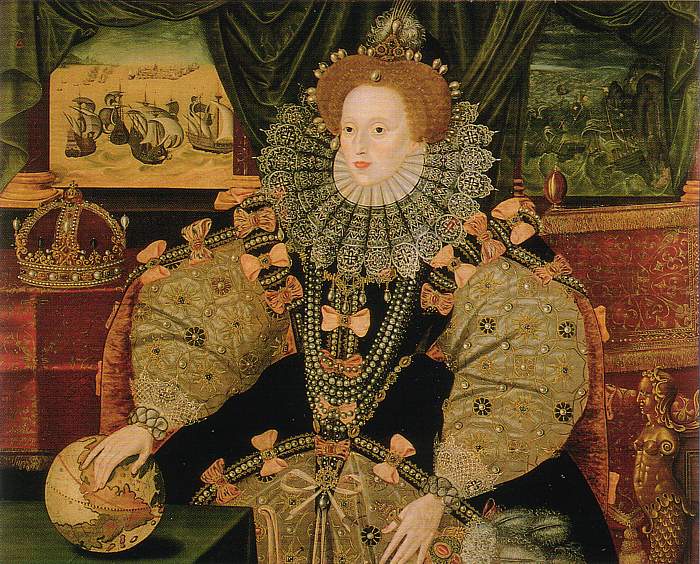
The UK is looking to raise £10 million ($14.46 million) to buy a life-size portrait of Queen Elizabeth I from the descendants of Francis Drake, reports the BBC. If the campaign is successful, the painting, which has been in private hands for the entirety of its 425-odd-year existence, would enter the collection of the Royal Museums Greenwich (RMG).
The canvas is one of three surviving versions of the Queen’s Armada portrait, painted to commemorate the failed invasion of England by the Spanish Armada in 1588. The other two belong to Woburn Abbey in Bedfordshire and the National Portrait Gallery in London. The symbolic portrait shows the Queen with a globe, demonstrating her plans to expand her empire to the New World. In the background are two scenes from her victory against Spain.
Some art historians believe the painting was commissioned by Drake himself, and the work has been owned by his family since at least as far back as 1775. It was loaned to the National Maritime Museum, part of the RMG, for exhibitions in 1998 and 2003, but has rarely been on public display.
The artist is unknown, but is thought to have been George Gower or Nicholas Hilliard.
Portrait of Sir Francis Drake in The world encompassed. Public domain.
The Tyrwhitt-Drake family hopes to sell the piece to the British institution in order to receive an inheritance tax exemption. If the Royal Museums are unable to raise the money, the painting will be sold on the open market, where it is expected to command a far-higher price, in the region of £16.25 million ($23.5 million). Should the historic work be poised to leave the country, the Department of Culture, Media, and Sports would likely issue a temporary export ban in order to give UK buyers a second chance.
Export bans are quite common for culturally-significant historic objects that are sold to international collectors, but raising the necessary funds to keep such artworks in the UK permanently can present quite a challenge. In February, for instance, culture minister Ed Vaizey gave the UK the opportunity to match the £2 million ($2.9 million) purchase price for Femme, the only plaster Alberto Giacometti sculpture in the country. The export ban ends tomorrow, May 24, but to date there has been no further news on the fundraising effort.
Meanwhile, Vaizey has extended the export ban on a dagger and set of white robes belonging to Lawrence of Arabia until July 1, according to the Independent. The department is hopeful funds for the £122,500 ($177,400) dagger and £12,500 ($18,100) robes will soon be raised, thanks to the efforts of the UK’s Middle East minister Tobias Ellwood.
Lawrence of Arabia’s dagger. Courtesy the Department of Culture, Media, and Sports.
Success stories include the £2.5 million ($3.8 million) Wolsey Angels, the £2.7 million ($4.5 million) Wedgwood Collection, and a £10 million ($16.6 million) Van Dyck self portrait purchased by the National Portrait Gallery. Other efforts, however, have met with failure, such as a rare Charles Le Brun portrait defied the export ban and went to New York’s Museum of Metropolitan Art.
As for the Queen Elizabeth portrait, the campaign is promising: The Art Fund has pledged to contribute £1 million, while the RMG is chipping in £400,000. A group of supporters has said it would match all public contributions. If their efforts are successful, the RMG plans to hang the work in the Queen’s House, located on the site of the Greenwich Palace, where the Queen was born in 1553.